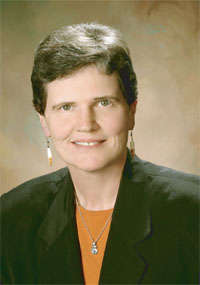HHS awards up to $22.4 million for suicide prevention

Pamela Hyde
The U.S. Department of Health and Human Services (HHS) this month announced a grant of up to $22.4 million for suicide prevention, some of which will be used to address the needs of LGBT youth.
The grant came two weeks after leaders of the U.S. House’s LGBT Equality Caucus called on HHS to do more to stop suicides among LGBT youth, saying such suicides were “a serious public health problem which cannot wait.” But the grant was in progress long before the letter.
The money—from HHS’ Substance Abuse and Mental Health Services Administration (SAMHSA)—will re-fund the Suicide Prevention Resource Center (SPRC), which helps organizations and individuals develop suicide prevention programs and policies. The five-year grant will allow the Center, among other things, to increase its focus on high-risk populations such as LGBT youth, according to a press release.
Anara Guard, senior advisor at SPRC, said there was no way to break out how much money would go toward any one population or activity, because that was not how the grant proposal was written.
SAMHSA spokesperson Nancy Ayers noted the grant was not in response to the recent media attention surrounding a number of suicides by LGBT youth. Guard said the grant application process had begun in February, and funding began September 30 (although the public announcement came later).
On October 26, U.S. Reps. Jerrold Nadler (D-N.Y.), Barney Frank (D-Mass.), Tammy Baldwin (D-Wisc.), and Jared Polis (D-Colo.) sent a letter to SAMHSA Administrator Pamela S. Hyde, asking that the agency take “immediate action . . . to better protect LGBT youth and prevent further tragedies.”
Hyde is one of President Obama’s LGBT appointees.
The letter questioned SAMHSA’s recent draft plan, Leading Change, and asked whether the agency is putting enough emphasis on “specific suicide prevention efforts” aimed at LGBT youth. Suicides among this group, the representatives wrote, are “caused by a culture of bullying, hostility, and violence against the LGBT community. Young LGBT Americans thus face unique challenges which require specific and targeted prevention efforts.”
The representatives noted that Leading Change does mention an intention to address the needs of LGBT youth, but they are concerned that this is secondary to other objectives.
They ask Hyde to detail current and future plans in this area, and ask whether SAMHSA anticipates needing “additional resources or legal authority” to accomplish them.
“We want to be helpful,” said Ilan Kayatski, a spokesperson for Rep. Nadler. “The intent is to urge them to do all they possibly can under their current authority and to ask them if they have everything they need.” He also said that some resources could come from existing programs, but they are prepared to “provide legal authority and additional resources through legislation if necessary.”
Dr. Richard McKeon, Suicide Prevention Branch Chief at SAMHSA, said in an interview October 19 that SAMHSA has several grant programs for preventing youth suicide, but none specific to LGBT youth.
He noted that SAMHSA’s National Suicide Prevention Lifeline works closely with the Trevor Project, which runs a suicide prevention lifeline for LGBT youth. It will even transfer calls from LGBT youth directly to Trevor. Charles Robbins, Trevor’s executive director, sits on the Consumer Subcommittee for the National Lifeline. But Robbins said the Trevor Project receives no money from SAMHSA.
The SAMHSA-funded SPRC was created in 2002 after the 2001 National Strategy for Suicide Prevention (developed under the Clinton administration) recommended such a center. It has taken several steps to address suicide risk and prevention in the LGBT community.
In 2007, it partnered with the Gay and Lesbian Medical Association and American Foundation for Suicide Prevention to host a conference on the topic.
SPRC then released a 63-page white paper in 2008 on suicide among LGBT youth. Guard said that after doing so, they had more speaking requests than they could accommodate. They are therefore now creating a Workshop Kit that draws from the white paper and is designed for people in schools and other youth-serving organizations. She expects the kits to be available this winter.
SPRC is also providing administrative and infrastructure support to the new National Action Alliance for Suicide Prevention. The Alliance, which officially launched on September 10, is a public-private partnership designed to advance and update the 2001 Strategy. Such a partnership was envisioned in the Strategy itself to help guide its implementation.
SAMHSA official McKeon acknowledged that it has taken some time for the Alliance to be created, but “We were really pleased by the people who stepped forward to make it happen now,” including SAMHSA Administrator Hyde, Secretary of Health Kathleen Sebelius, and Secretary of Defense Robert Gates.
In her speech at the Alliance kickoff, Sebelius noted that LGBT youth were a high-risk group.
Two notable members of the Alliance executive committee are Trevor’s Robbins and Kevin Jennings, now Assistant Deputy Secretary for the Office of Safe and Drug-Free Schools (OSDFS) at the Department of Education. Jennings is also the founder of the Gay, Lesbian, and Straight Education Network (GLSEN).


Leave a Reply